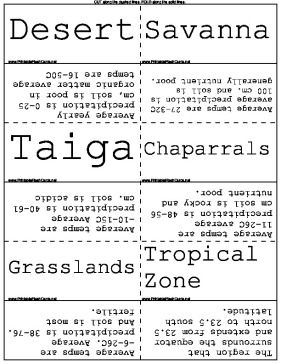

Learning about different biomes in science? This set of flash cards will help you remember the qualities of several biomes, as well as several other important terms relating to these regions.
There are 15 flash cards in this set (3 pages to print.)
To use:
1. Print out the cards.
2. Cut along the dashed lines.
3. Fold along the solid lines.
Sample flash cards in this set:




| Questions | Answers |
|---|---|
| Desert | Average yearly precipitation is 0-25 cm, soil is poor in organic matter average temps are 16-50C |
| Savanna | Average temps are 27-32C average precipitation is 100 cm. and soil is generally nutrient poor. |
| Taiga | Average temps are -10-15C Average precipitation is 40-61 cm. soil is acidic |
| Chaparrals | Average temps are 11-26C average precipitation is 48-56 cm soil is rocky and nutrient poor. |
| Grasslands | Average temps are -6-26C. Average precipitation is 38-76. And soil is most fertile. |
| Tropical Zone | The region that surrounds the equator and extends from 23.5 north to 23.5 south latitude. |
| Tundra | average temperature is -27-5C average precipitation is 0-25 cm and soil is frozen. |
| Latitude | The distance north or south from the equator |
| Weather | Condition of the atmosphere at a certain time. |
| Elevation | The height of an object above sea level. |
| Rainforest | Average temperature 25-28C average precipitation yearly is 200cm or more, and soil is thin and nutrient poor. |
| Forests | Average temperatures are 0-28C. average yearly precipitation is 76-250 soil is fertile and organically rich |
| Climate | The average weather condition in an area over a long period of time. |
| Prevailing winds | Winds that blow mainly from one direction |
| Polar Zone | The north or south pole and its surrounding area. |